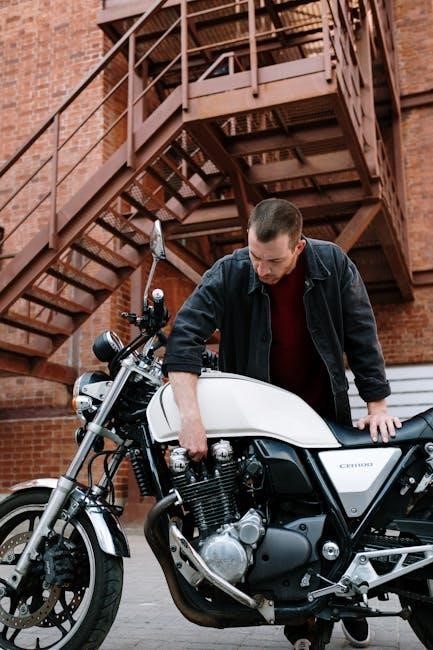Motorcycle Jacket Size Guide: Finding the Perfect Fit
Finding a motorcycle jacket that fits perfectly is key for comfort and safety. Size charts, alpha & numeric sizing, and brand variations all matter.
Get ready to learn about accurate measurements, riding posture considerations, and tips to choose between sizes.
Why Proper Fit Matters for Motorcycle Jackets
The fit of your motorcycle jacket is critical for several reasons. Firstly, a snug fit, as motorcycle jackets are designed, protects the rider from the elements. A jacket that’s too large will flutter in the wind, causing discomfort and distraction, while a jacket that’s too small will restrict movement and be equally uncomfortable. Proper fit is important to be able to ride the motorcycle comfortably and safely.
Secondly, a well-fitted jacket offers optimal protection in the event of a crash. Motorcycle jackets are typically designed to be trim fitting, in order to protect the rider in the event of an accident. A loose jacket may shift or ride up, leaving vulnerable areas exposed. Armor should stay in place to protect your body. A snug fit ensures that the jacket’s protective armor stays in the correct position to absorb impact and minimize injuries.
Thirdly, comfort plays a crucial role in rider fatigue. A properly fitted jacket allows for a full range of motion without binding or chafing. This freedom of movement is essential for maintaining control of the motorcycle and reducing strain on long rides.
Finally, layering is an important consideration. A jacket that fits well with your usual riding gear, including base layers and sweaters, will provide greater versatility in different weather conditions.
In short, the right motorcycle jacket fit enhances safety, comfort, and overall riding experience.

Key Measurements for Accurate Sizing
To determine the correct motorcycle jacket size, accurate body measurements are essential. The most important measurements are chest, waist, and sleeve length.
Chest: Measure around the fullest part of your chest, keeping the measuring tape horizontal and snug but not too tight. Make sure to measure over a shirt or light sweater to account for layering; It is measured just below the armpit area with your chest expanded.
Waist: Measure around your natural waistline, which is typically the narrowest part of your torso. Keep the measuring tape snug but not constricting.
Sleeve Length: This measurement is taken from the center of the back of your neck, over the shoulder, and down to the wrist bone. It’s helpful to have someone assist you with this measurement to ensure accuracy. Or, measure from the shoulder seam down to the wrist bone.
In addition to these key measurements, some manufacturers may also provide size charts that include measurements for bicep circumference, shoulder width, and back length. Consulting these charts can help you fine-tune your size selection.

When taking measurements, it’s important to use a flexible measuring tape and to stand in a relaxed, upright posture. Avoid slouching or tensing your muscles, as this can affect the accuracy of your measurements.
Remember to record your measurements in both inches and centimeters, as size charts may be presented in either unit.
Finally, it’s always a good idea to take measurements more than once to ensure consistency.
Understanding Motorcycle Jacket Size Charts (Alpha vs. Numeric)

Motorcycle jacket size charts can seem confusing at first glance, but understanding the different sizing systems can make the process much simpler. There are two primary types of sizing used for motorcycle jackets: alpha sizing and numeric sizing.
Alpha Sizing: Alpha sizing uses letters to indicate size, such as XS (extra small), S (small), M (medium), L (large), XL (extra large), and so on. Alpha sizing is often used for more casual or general-purpose jackets. The conversion of this sizing system to a standard chest size will vary by manufacturer, so always consult the size chart.
Numeric Sizing: Numeric sizing, on the other hand, uses numbers to represent size, typically based on chest measurements in inches or centimeters. For example, a jacket might be labeled as a size 40, which corresponds to a 40-inch chest circumference. Also, pay attention to any fitment notes on a jackets product page. If a jacket has a funky fit, it’ll be notated so you can order the correct size.
When using a size chart, it’s important to pay attention to the specific measurements provided for each size. Don’t assume that a particular alpha size (e.g., M) will always correspond to the same numeric size across different brands.
Some size charts may also include additional measurements, such as sleeve length, shoulder width, and back length. Use these measurements to fine-tune your size selection and ensure a comfortable and functional fit.
Keep in mind that sizing can vary significantly between brands and even between different styles within the same brand. Always refer to the size chart for the specific jacket you’re considering before making a purchase.
Also note that some jackets may be designed with a more tailored or athletic fit, while others may have a more relaxed or generous cut. Consider your personal preferences and riding style when choosing a size.

Brand-Specific Sizing Variations
One of the most crucial aspects of finding the perfect motorcycle jacket fit is understanding that sizing can vary significantly from one brand to another. Just like with regular clothing, there’s no universal standard for sizing in the motorcycle apparel industry. This means that a size Large jacket from one brand might fit like a Medium or an Extra Large from another. This inconsistency stems from different design philosophies, manufacturing processes, and target markets.
Some brands, particularly those with a European heritage, tend to have a more tailored or “Euro” fit, which means their jackets may run smaller than their American counterparts. Italian jackets are often known for their slim fits, while UK and German manufacturers might offer more generous cuts around the waist. Other brands may cater to specific body types or riding styles, resulting in variations in sizing.
To navigate these brand-specific sizing variations, it’s essential to consult the size chart provided by the manufacturer of the jacket you’re interested in. Don’t rely solely on your usual jacket size, as it may not be accurate for every brand. Always refer to the brand’s size chart and compare your measurements to the measurements listed for each size.
Some brands may also provide fitment notes or recommendations on their product pages, indicating whether a particular jacket tends to run small, large, or true to size. Pay attention to these notes, as they can offer valuable insights into the jacket’s fit. If possible, trying on jackets from different brands in person is always the best way to ensure a proper fit.
Remember that even within the same brand, sizing can vary between different styles of jackets. A race-oriented jacket, for example, may have a more snug and aerodynamic fit than a touring jacket, which is designed for comfort and freedom of movement. Always check the size chart for the specific jacket you’re considering, regardless of your experience with other jackets from the same brand.
Accounting for Riding Posture and Layering
When selecting a motorcycle jacket, it’s not enough to simply find a size that fits comfortably when you’re standing upright. You need to account for your riding posture and the layers you’ll be wearing underneath the jacket. Your riding posture can significantly impact how a jacket fits and feels, as it changes the way your body is positioned and how the fabric drapes.
Most motorcycle jackets are designed with a pre-curved shape in the arms and shoulders to accommodate the forward-leaning riding position. This pre-curvature allows for greater comfort and freedom of movement when you’re on your bike. However, if the jacket is too tight or too loose, the pre-curvature may not align properly with your body, leading to discomfort and restricted movement.
To ensure a proper fit in your riding posture, try on the jacket while sitting on a motorcycle or mimicking a riding position. Pay attention to how the jacket feels across your shoulders, chest, and back. Make sure you can comfortably reach the handlebars without feeling restricted or strained. The sleeves should be long enough to cover your wrists when your arms are extended, and the jacket should not ride up excessively in the back.
Layering is another important factor to consider when sizing a motorcycle jacket. Depending on the weather conditions, you may need to wear multiple layers of clothing underneath your jacket for warmth or protection. These layers can add bulk and affect the fit of the jacket.
When trying on a jacket, wear the type of layers you would typically wear while riding. This could include a base layer, a mid-layer fleece or sweater, and any protective armor you plan to use. Make sure the jacket still fits comfortably with these layers on, without feeling too tight or restrictive. You should have enough room to move freely and operate the controls of your motorcycle without any difficulty.
If you plan on wearing a thicker insulated liner in colder weather, you may need to go up a size in your jacket to accommodate the extra bulk. Some jackets come with removable liners, which can be helpful for adjusting the fit based on the season.
Remember that it’s always better to err on the side of slightly too large than too small when it comes to motorcycle jacket sizing. A jacket that’s too tight can be uncomfortable, restrictive, and even dangerous, while a jacket that’s slightly too large can be adjusted with straps or other features.
Fit Considerations: Snug vs. Loose
The ideal fit for a motorcycle jacket is a balance between being snug enough to provide protection and loose enough to allow for comfortable movement and layering. There’s no one-size-fits-all answer, as the best fit depends on personal preference, riding style, and the type of jacket. However, understanding the pros and cons of each fit can help you make an informed decision.
A snug fit, often preferred for sport or racing jackets, offers several advantages. It minimizes wind resistance, which can reduce fatigue at high speeds. It also ensures that the armor stays in place during a crash, providing maximum protection. A snug jacket also tends to feel more responsive and connected to the bike, enhancing the riding experience. However, a jacket that’s too snug can restrict movement, especially when reaching for the handlebars or checking blind spots. It can also become uncomfortable on long rides, particularly in hot weather. Layering can also be difficult with a snug-fitting jacket.
A looser fit, more common in touring or cruiser jackets, prioritizes comfort and versatility. It allows for greater freedom of movement, making it easier to ride for extended periods. It also provides more room for layering, which is essential for adapting to changing weather conditions. A looser jacket can also be more comfortable in hot weather, as it allows for better airflow. However, a jacket that’s too loose can flap in the wind, creating drag and increasing fatigue. It can also compromise the effectiveness of the armor, as it may shift out of position during a crash.
When deciding between a snug and loose fit, consider your riding style and priorities. If you primarily ride at high speeds or participate in track days, a snug fit may be preferable. If you prioritize comfort and versatility for long-distance touring or commuting, a looser fit may be a better choice.
Regardless of the fit you choose, it’s essential to ensure that the jacket provides adequate protection. The armor should fit snugly over your joints without restricting movement. The jacket should also be long enough to cover your lower back when you’re seated on the motorcycle.
Some jackets offer adjustable features, such as waist belts, arm adjusters, and cuff closures, which can help you fine-tune the fit. These features can be particularly useful if you’re between sizes or if you want to customize the fit based on the weather conditions.
Ultimately, the best way to determine the ideal fit is to try on different jackets and see what feels most comfortable and secure. Don’t be afraid to spend some time in the store, mimicking your riding posture and layering options, to ensure that you’re making the right choice.
Measuring Chest, Waist, and Sleeve Length
Accurate measurements are the foundation of finding a motorcycle jacket that fits well. The three most important measurements are chest circumference, waist circumference, and sleeve length. Taking these measurements correctly will significantly improve your chances of selecting the right size and avoiding the hassle of returns or exchanges. It’s best to have a friend or family member assist you to ensure the most accurate results.
Chest Measurement: Stand in a relaxed posture with your arms at your sides. Have your assistant wrap a flexible measuring tape around the fullest part of your chest, under your armpits. Ensure the tape is level and snug but not too tight. It should be comfortable enough to breathe normally. The tape should sit across your back and meet in the front, giving you the circumference of your chest. For women, wear a bra that you would typically wear while riding to ensure an accurate measurement. Record the measurement in inches or centimeters, depending on the size chart you’ll be using.
Waist Measurement: Locate your natural waistline, which is typically the narrowest part of your torso, just above your hip bones. Stand relaxed and have your assistant wrap the measuring tape around your waist, keeping it level. Again, the tape should be snug but not constricting. Avoid sucking in your stomach or tightening your core, as this will result in an inaccurate measurement. Record the measurement in inches or centimeters.
Sleeve Length Measurement: This measurement is crucial for ensuring that the jacket sleeves are long enough to cover your wrists while riding, preventing cold air from entering and protecting your skin in case of a fall. Place your arm slightly bent at your side. Have your assistant measure from the center of the back of your neck (where a shirt tag would sit), across your shoulder, and down the outside of your arm to your wrist bone. Alternatively, some manufacturers measure from the shoulder seam down the arm to the wrist. Use the measurement method provided by the brand’s size chart.
Important Considerations:
- Wear appropriate clothing: When taking measurements, wear the type of clothing you would typically wear under your motorcycle jacket. This could include a t-shirt, a light sweater, or a base layer, depending on the weather conditions you usually ride in.
- Use a flexible measuring tape: A cloth or flexible measuring tape is essential for accurate measurements. Avoid using metal measuring tapes, as they are not flexible and can be difficult to work with.
- Record measurements accurately: Double-check your measurements to ensure accuracy. It’s helpful to record the measurements in both inches and centimeters, as different brands may use different units.
- Refer to brand-specific size charts: Once you have your measurements, compare them to the size chart provided by the specific motorcycle jacket manufacturer. Sizing can vary significantly between brands, so it’s crucial to use the correct size chart.
By taking accurate chest, waist, and sleeve length measurements, you’ll be well-equipped to find a motorcycle jacket that fits comfortably and provides the necessary protection.
Tips for Choosing Between Sizes
Sometimes, your measurements may fall between two sizes on a motorcycle jacket size chart. This can make it difficult to decide which size to choose. Here are some helpful tips to guide you in making the best decision for your comfort and safety while riding:
Consider Your Body Type: Your body shape can influence how a jacket fits. If you have broader shoulders or a larger chest, you might want to opt for the larger size to ensure a comfortable fit across the upper body. Conversely, if you have a slimmer build, the smaller size might be a better choice to avoid excessive fabric flapping in the wind.
Think About Layering: If you plan to wear additional layers under your motorcycle jacket, such as a thermal base layer or a thicker sweater during colder months, it’s generally recommended to choose the larger size. This will allow for adequate room for the extra layers without restricting your movement or compressing your body.
Check the Jacket’s Intended Fit: Some motorcycle jackets are designed for a more snug, athletic fit, while others offer a more relaxed or touring-oriented fit. Consider the jacket’s intended fit when choosing between sizes. If the jacket is designed to be snug, you might want to size up if you’re between sizes. If it’s designed to be relaxed, the smaller size might work better.
Read Customer Reviews: Customer reviews can provide valuable insights into the sizing accuracy of a particular motorcycle jacket. Look for reviews that specifically mention sizing issues or whether the jacket runs true to size, small, or large. This information can help you make a more informed decision.
Consult the Retailer’s or Manufacturer’s Website: Many retailers and manufacturers provide detailed sizing information and fit guides on their websites. Look for these resources, as they may offer specific recommendations for choosing between sizes based on the jacket’s design and construction.
When in Doubt, Size Up: If you’re still unsure which size to choose, it’s generally better to size up rather than size down. A jacket that is slightly too large can be adjusted with the jacket’s features, such as adjustable straps or closures. A jacket that is too small, on the other hand, can be uncomfortable and restrictive, and it may not provide adequate protection.
Try It On If Possible: The best way to determine the right size is to try the jacket on in person, if possible. Visit a local motorcycle gear shop and try on both sizes to see which one feels more comfortable and allows for a greater range of motion. Sit on a motorcycle while wearing the jacket to simulate your riding posture and ensure that it doesn’t restrict your movement or bunch up in uncomfortable places.
Consider the Sleeve Length: Pay close attention to the sleeve length when choosing between sizes. The sleeves should be long enough to cover your wrists while you’re reaching forward on your motorcycle’s handlebars. If the sleeves are too short, they will ride up and expose your skin to the elements.
Check the Return Policy: Before making a final decision, be sure to check the retailer’s return policy. If you’re unsure about the size, it’s helpful to purchase the jacket from a retailer that offers a hassle-free return policy, so you can exchange it for a different size if necessary.
By following these tips, you can increase your chances of choosing the right size motorcycle jacket, even when your measurements fall between sizes.
